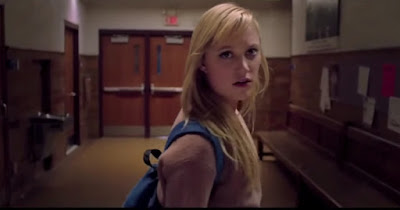Like A Nightmare on Elm Street or Final Destination, It Follows has a simple premise - one that is ridiculous but perfect for the horror genre, the kind of scary story that could be told around a campfire or at slumber parties. A strange curse is being passed around - if you have sex with a person who has It, something will start following you. Nobody else can see it but you. It takes different human forms, sometimes of people you know. It will always be walking towards you - slowly but inevitably. If it catches you, you're dead. You can pass it on by sleeping with somebody else, but if It catches them, It will just follow you again.United States, 2015Directed by David Robert Mitchell
It's an absurd but catchy plot hook, and one that It Follows utilizes very cleverly. Though there are grotesque moments, director David Robert Mitchell shows restraint when it comes to violence and cheap "boo!" scares - It Follows draws most of its horror from the creeping tension inherent to its premise, the mystery of not knowing where or who It is, and of suddenly recognizing It moving inevitably towards you. Clever camerawork builds suspense - as in a rotating 360-degree shot, where with each rotation It grows steadily closer.
There's a very obvious metaphor to be found here, It as the embodiment of an STD. It Follows acknowledges this metaphor early on, but moves on quickly - It gains larger, vaguer meanings than just the menace of sexually transmitted disease.
It also represents anxieties about impending adulthood and the loss of childhood's safety and innocence. The characters of It Follows are unusually believable for the horror genre, which often casts 30 year old supermodels to play teenagers. They look and behave like real young adults, all reminiscent of people I knew in high school, with a convincing, low-key camaraderie among them. And all of them are adrift in a late adolescent limbo - still living with parents in their childhood homes, but facing the encroachment of dangerous adult responsibilities. Two characters play a "trading places" game while waiting in line for a movie - where they observe the strangers around them and pick who they would most like to trade lives with. The young man picks a little boy, because he still "has his whole life ahead of him". This sounds like a ridiculously melodramatic thing for a young person to say, but there's a relatable truth to it. Many stories show the exciting promise and freedom of being a young adult but It Follows explores the darker flip side. Emerging from the innocent bubble of childhood into adult knowledge can be dreadful - a new awareness of your fragile place in a sometimes scary world, with mortality creeping closer.
Then there's the odd absence of parents. Adults are only glimpsed briefly in It Follows, and their lack of presence is pointedly intentional. We never see our main character Jay's mother clearly - her face is always just out of the picture or blurry, she always has a wine glass nearby, and Jay never goes to her for help or advice during her ordeal. Where Jay's father is, we don't know - but it's suggested that he is the final form It takes in the film, a storytelling decision that surely was not meaningless. These kids are on their own, and perhaps their entry in adulthood would not have been so treacherous if they had loving guidance from their elders.
It Follows never tells us what to think about these ideas, they remain haunting, unresolved undercurrents to a pretty terrific horror movie. It Follows is not perfect - it violates the rules it sets up several times, which is a storytelling pet peeve of mine. But it is a thoughtful, artfully-crafted gem in a genre that largely produces rubbish, and it gets so much just right. I dug its dreamy retro style, which is like a cross between Sofia Coppola and John Carpenter - and that score is seriously awesome.



